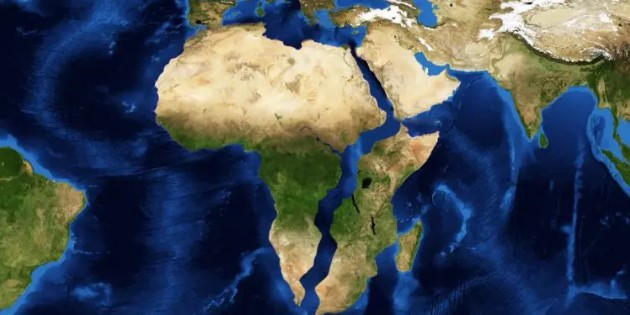AFRICAN CONTINENT TO SPLIT INTO TWO WITH FORMATION OF NEW OCEAN

By: John Ikani
Photo: The Heritage Times
Geologists have confirmed that the African continent is gradually splitting into two, with the formation of a new ocean. An international study has shown that a 35-mile-long rift that emerged in the Ethiopian deserts of the Far region in 2005 is most likely the beginning of a new ocean.
The recently published study in the Geophysical Research Letters Journal, combines seismic data from the rift formation to demonstrate that it is being driven by processes similar to those that occur at the bottom of the ocean.
The collision of the African and Arabian tectonic plates in the desert is responsible for the gradual separation of the two plates over the last 30 million years. It is the same motion that created the Red Sea, but at a much slower rate of just a fraction of an inch per year.
There has been widespread shock and amazement at the prospect and possibility of a new ocean forming in Africa, as reported by the Kenya Broadcasting Cooperation (KBC).
Dr. Edwin Dindi of the Department of Geology in the Faculty of Science and Technology at the University of Nairobi, believes it is possible that an ocean is indeed forming along the eastern arm of the African Rift Valley.
Dr. Dindi explains that the tectonic plates are in a state of constant flux, with some shifting against each other along fault zones, others falling beneath one another, and some crashing against one another, tearing apart from each other at divergent plate boundaries.
This motion has led to the formation of the continents we know today, including; Africa, South America, North America, Europe, Asia, and Australia.
The continuous motion within the continental crust has seen the formation of the East African Rift Valley, which continues to widen and become more active. While the formation of a new ocean in Africa is likely, Dr. Dindi cautions that it will take millions of years to occur.
The thickness around the rift valley has already reduced from 40 kilometers to 35 kilometers over the past 30 million years, so it will take many more years to shed off another 5 kilometers.
Dr. Dindi also notes that not all rift valleys form to the state of the current ones, as some fail, like the one that had begun forming around Wajir in the northeastern part of Kenya, which failed and was instead covered with sediments.
The East African Rift Valley, also known as the Afro-Arabian Rift Valley, is one of the most extensive rifts on Earth’s surface, extending from Jordan in southwestern Asia southward through eastern Africa to Mozambique. The system is about 6.400 kilometers long and averages between 48 to 64 kilometers wide.



